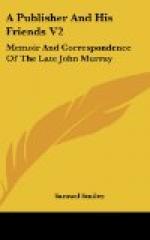These are the general outlines; and if you entertain a notion that the conjunction will suit you, advise me, and you shall be assumed upon equal terms; for I write to you before the affair is finally settled; not that I shall refuse it if you don’t concur (for I am determined on the trial by myself); but that I think it will turn out better were we joined; and this consideration alone prompts me to write to you. Many Blockheads in the Trade are making fortunes; and did we not succeed as well as they, I think it must be imputed only to ourselves. Make Mrs. McMurray’s compliments and mine to Mrs. Falconer; we hope she has reaped much benefit from the saltwater bath. Consider what I have proposed; and send me your answer soon. Be assured in the meantime, that I remain, Dear Sir,
Your affectionate and humble servant,
JOHN McMURRAY.
P.S.—My advisers and directors in this affair have been Thomas Cumming, Esq., Mr. Archibald Paxton, Mr. James Paterson of Essex House, and Messrs. J. and W. Richardson, Printers. These, after deliberate reflection, have unanimously thought that I should accept Mr. Sandby’s offer.
Falconer’s answer to this letter has not been preserved. It did not delay his departure from Dover in the Aurora frigate. The vessel touched at the Cape; set sail again, and was never afterwards heard of. It is supposed that she was either burnt at sea, or driven northward by a storm and wrecked on the Madagascar coast. Falconer intended to have prefixed some complimentary lines to Mr. Murray to the third edition of “The Shipwreck,” but they were omitted in the hurry of leaving London and England for India.
Notwithstanding the failure of MacMurray to obtain the aid of Falconer in his partnership, he completed alone his contract with Mr. Sandby. His father at Edinburgh supplied him with the necessary capital, and he began the bookselling business in November 1768. He dropped the prefix “Mac” from his surname; put a ship in full sail at the head of his invoices; and announced himself to the public in the following terms:
“John Murray (successor to Mr. Sandby), Bookseller and Stationer, at No. 32, over against St. Dunstan’s Church, in Fleet Street, London, sells all new Books and Publications. Fits up Public or Private Libraries in the neatest manner with Books of the choicest Editions, the best Print, and the richest Bindings. Also, executes East India or foreign Commissions by an assortment of Books and Stationary suited to the Market or Purpose for which it is destined; all at the most reasonable rates.”
Among the first books he issued were new editions of Lord Lyttelton’s “Dialogues of the Dead,” and of his “History of King Henry the Second,” in stately quarto volumes, as well as of Walpole’s “Castle of Otranto.” He was well supported by his friends, and especially by his old brother officers, and we find many letters from all parts of the world requesting him to send consignments of books and magazines, the choice of which was, in many cases, left entirely to his own discretion. In 1769 he received a letter from General Sir Robert Gordon, then in India, who informed him that he had recommended him to many of his comrades.




